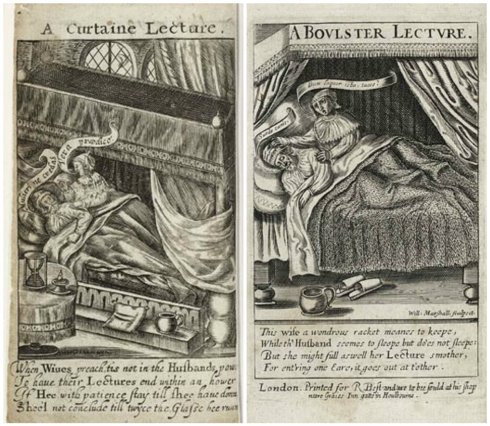It was Burns Night at Hamilton Hall last night, and my husband and I were charged with giving the Toast to the Lassies and Reply. After a week steeped in the Ploughman Poet, both of us were a bit uncomfortable with the very bawdy Burns in this year of #metoo, so he went with the more inspiring Rights of Woman as the basis of his toast, which meant I had to go for the uplifting too. But I kind of wish he had gone with one of my favorite Burns poems, The Henpecked Husband. I don’t like it for its overall sentiment, of course, but because of just one phrase, curtain lecture, an idiom which I’ve used in class time and time again, because it always provokes a conversation!
The Henpecked Husband
Curs’d be the man, the poorest wretch in life, The crouching vassal to a tyrant wife! Who has no will but by her high permission, What has not sixpence but in her possession; Who must to he, his dear friend’s secrets tell, Who dreads a curtain lecture worse than hell. Were such the wife had fallen to my part, I’d break her spirit or I’d break her heart; I’d charm her with the magic of a switch. I’d kiss her maids, and kick the perverse bitch.
Burns certainly didn’t coin this phrase; it had been around for quite a while. In my courses, I use the frontispieces from Thomas Heywood’s Curtaine Lecture (1637) and Richard Brathwaite’s Art Asleep, Husband? (1640) but I think the expression predates these works as well. It seems very Shakespearian to me, but the heavily-curtained seventeenth-century bed provides the perfect “frame” for wifely “advice”.

If you pop these images up before a class of 19-year-olds you are immediately rewarded with their focused engagement in the history of women, marriage, gender relationships, satirical discourse, and material culture (inevitably their attention strays to the “alarm clock” on the table in the Heywood illustration). Lots of comments, lots of questions, all of which can be contextualized and connected to other timely trends. Obviously the notion had a wide appeal—or recognition–in the seventeenth century and after, which is why it survived up until Burns’ time. In an earlier post, I showed the Richard Newton caricature that dates from around the time of The Henpecked Husband, and it is one of many variations on the theme published in this era, give or take a few decades. As the era of curtained-beds closed, the curtain lecture continued, and was revived quite dramatically by the publication of Mrs. Caudle’s Curtain Lectures by Douglas Jerrold in Punch in 1845. These 37 illustrated lectures were published in book form that same year, and reissued frequently thereafter, inspiring a wave of variant visual expressions in all sorts of mediums: stereoviews, postcards, even a board game. Now it is a general rule of mine that once animals (or birds) take the place of people a concept has jumped the shark (with a few exceptions), and it’s hard to conceive the curtain lecture could have lasted through the twentieth century in any case, but nevertheless it survives as an effective teaching tool.







 A Curtain Lecture pub. by J. Lewis Marks, 1824, British Museum; illustrations by John Leech for the first edition of Mrs. Caudle’s Curtain Lectures, 1845; Mrs. Caudle Card (with real hair!), Victoria & Albert Museum; 1907 stereoview from the Library of Congress; postcards, c. 1900-1910.
A Curtain Lecture pub. by J. Lewis Marks, 1824, British Museum; illustrations by John Leech for the first edition of Mrs. Caudle’s Curtain Lectures, 1845; Mrs. Caudle Card (with real hair!), Victoria & Albert Museum; 1907 stereoview from the Library of Congress; postcards, c. 1900-1910.






January 28th, 2018 at 3:42 pm
The curtain lectures are great. I love Burns in general, although I think it wise to curtail the lusty aspects sometimes in public.
Our household is awaiting the arrival of the Burdick’s Robert Burns chocolate collection which they only sell this time of year, all made with varieties of whiskey–
January 29th, 2018 at 10:44 am
I was VERY happy with the selection of scotches they used this year!
January 29th, 2018 at 11:30 am
I can’t wait for ours!
January 28th, 2018 at 4:56 pm
Dear Professor, Curtain Lectures sound dreadful..I’d much rather pillow talk.
Thank you for continuing to educate and inspire me.
January 28th, 2018 at 7:17 pm
I LOVE those ducks. Actually those chickens are pretty funny too!
January 29th, 2018 at 12:46 am
Thank you for the post – enjoyed very much.
January 29th, 2018 at 10:49 am
I was at a Burns Night celebration with folk singers last week. Yes, Burns’s love life, and his hardly exemplary treatment of women was a subject of comment and expressed reservations about Burns himself.
Which does lead to a question of whether we are going to see a revaluation of the fabulous fornicators and philanderers of the past. What do we say about kings who used their power to take and discard mistresses at will?
January 29th, 2018 at 12:41 pm
I think this is a fascinating question. We know how the present loves to judge the past!
January 29th, 2018 at 2:43 pm
I was discussing that very topic over the dinner table last night. How does a historian best put into context behavior that would seem reprehensible now, but may have been acceptable then?
It doesn’t help that historians, when they turn into biographers, often fall in love with their subjects and lose their objectivity. I recall a biography of Philip II of Spain that exonerated him of any responsibility for religious persecutions by noting, among other things, that Philip never attended and auto-da-fe.